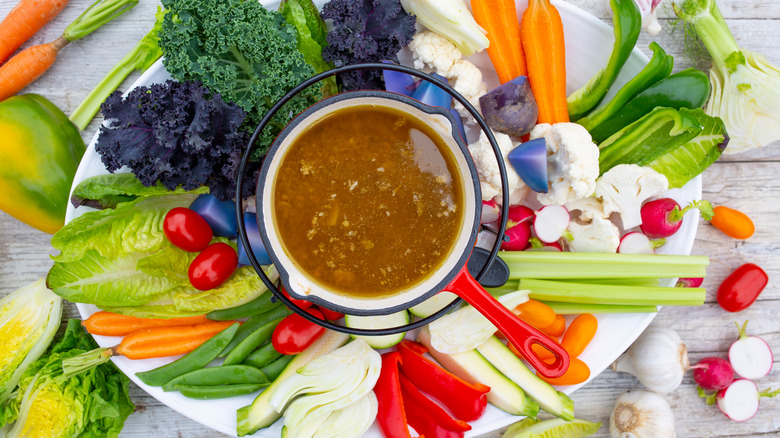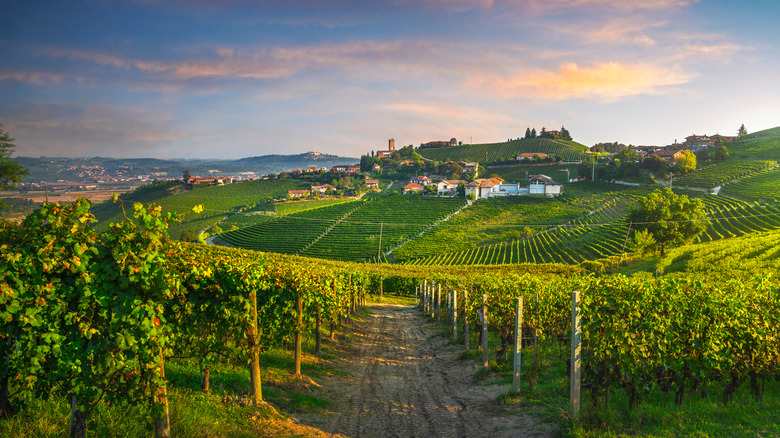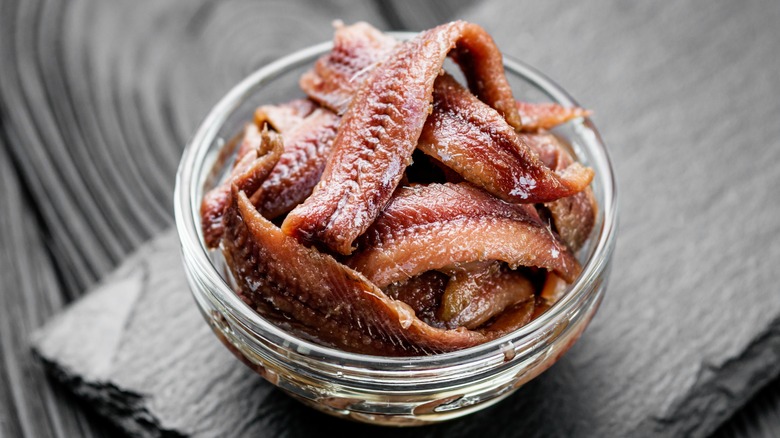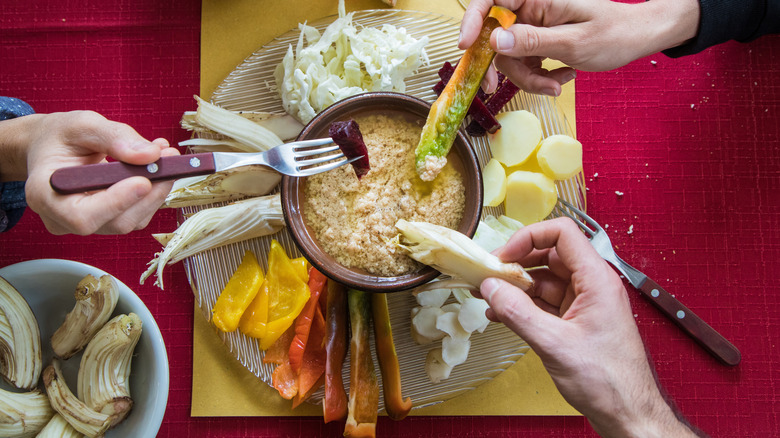Bagna Cauda: The Melted Anchovy Dip Roasted Vegetables Crave
Anyone can name some of the most indisputably best Italian culinary inventions. From the obvious answer of pizza to a dessert lover's likely choice of tiramisu or cannolis, it's widely accepted that Italy has long been an influential food capital of the world. Still, some of the nation's most delicious dishes have long been overlooked.
In fact, one of the best Italian fares out there may not even be a main course, but a tasty side dish made to combine with vegetables. According to The Kitchn, bagna cauda, which means "warm bath" in Italian, is a savory condiment that pairs perfectly with the caramelized taste of roasted veggies. Hailing from the Northern Italian region of Piedmont, this dip is famed for its simple ingredient list: Just garlic, olive oil, and — the most important part — melted-down anchovies. Even the pickiest of eaters will be dunking their veggies non-stop into this perfectly salty and buttery vegetable experience.
History of bagna cauda
According to Philo's Kitchen, bagna cauda can likely be traced all the way back to the Middle Ages. Since Piedmont lies on the French and Italian border, it was likely influenced by French culture. According to the outlet, many Piedmontese cities would buy salt from France's nearby Provence region. Serious Eats adds that this is important since this era saw salt being a heavily taxed and a prized commodity. Due to the high price, many merchants traveling between France and Italy hid salt underneath packed anchovies to avoid those taxes. Eventually, the Piedmontese people started including anchovies in many of their dishes, and it became a beloved regional staple.
Philo's Kitchen adds that bagna cauda itself was likely created due to this increased cultural exchange. It is thought to take direct inspiration from the Provençal dish, anchoiade. Anchoiade is a similar condiment made with both garlic and anchovies.
The outlet adds that bagna cauda was never a dish intended for nobility or upper-class citizens — it was always associated with farmers. However, when it was added to a late nineteenth-century cookbook, the dip skyrocketed in popularity. Today, you can find this dish in local restaurants or at many Italian family tables.
Ingredients in bagna cauda
According to Epicurious, olive oil, unsalted butter, anchovy filets, and plenty of garlic cloves make up the body of bagna cauda. While you may not expect the land-locked region of Piedmont to be famous for a dish with a staple seafood ingredient, this area has long been known for its anchovies. According to Great Italian Chefs, anchovies are a big deal in this region, and many of their other famous dishes include the fish. The outlet cites vitello tonnato, a classic Piedmontese dish that features boiled veal covered in a rich fish sauce made with anchovies and other varieties of fish.
While the ingredient list for bagna cauda is minimal, the pairings don't have to be. Feel free to lay out any assorted vegetables that you feel go well with this salty dip. Wine Enthusiast cites the Trinchero Family Estates who recommend "asparagus, broccoli, cauliflower, celery, fennel, radicchio, squash, and sweet peppers." While they dip raw or blanched vegetables into bagna cauda, roasted or grilled work fine as well. Also, make sure you use bite-sized pieces to make the dipping process easier, as per Epicurious.
And you can't forget the bread. Sliced baguette or Italian bread works fine, and it absorbs the golden liquid perfectly.
How bagna cauda is made and eaten
If you're looking for a quick dinner party appetizer or an easy communal mid-day snack, bagna cauda is one of the easiest go-to recipes for you. According to The New York Times, heat oil, butter, and garlic in a saucepan. After a few minutes, add diced anchovies, which will melt into the mixture. The mixture should be cooked, but it cannot reach boiling temperature, so watch it closely.
Once it's ready to eat, it is ideally poured into a fondue pot, as per Epicurious. However, if you do not have a fondue pot, any type of heat-containing dish that can be easily accessed by a group at a table works fine. It should be kept warm while everyone is enjoying dipping their veggies and bread.
According to Italian Delights, bagna cauda has long been served in the Piedmont region for certain important gatherings, such as the end of the harvest. It can also be a part of Christmas celebrations, as Epicurious adds. Typically, the dish is served in a terracotta pot with a flickering candle underneath to keep the dip warm.
Epicurious claims many Italians have a routine when eating this dish. First, the veggies are dipped into the sauce, but a slice of bread is placed underneath the veggies to absorb the excess oils. When the crusty bread is finally full of the sauce drippings, it can then be eaten and a new slice replaces it.



